Spadream dropped three marketing tools in favor of one and increased their email channel revenue by 8.8%
Spadream dropped three marketing tools in favor of one and increased their email channel revenue by 8.8%
Spadream — Is an online store for premium cosmetics offering global deliveries. Their product catalog contains over 118 brands.
At the end of 2018, Maestra replaced three separate tools for Spadream’s online store: two services for operating in the email channel and one for setting up product recommendations on-site.
The reasons for the transition relate to a lack of transparent analytics for comparing marketing costs against profits and the constant probability of mistakes occurring due to switching between service when assigning conditions for sending newsletters.
Over eight months of work “from one window”, store marketers:
- Increased email channel revenue share by 8.8%.
- Without outside help, establish conditions for triggered mailings, which bring the business 43% of the revenue from the entire email channel.
- Test product recommendations using a control group: people who see widgets on the site make 20% more orders.
- Helped the business owner reduce costs by switching from three services to one. The ROI from Maestra, as a customer data platform for email marketing, comes out to 176%.
Key figures
-
176%ROI from Maestra
-
43%Money brought in from automated mailings relative to the entire email channel
-
8.8% increaseIn revenue from the email channel in comparison to when Spadream utilized 3 separate marketing tools
-
20%more orders are made by people who see goods on the site based on Maestra recommendations
Monetary benefit from Maestra
Spadream uses four business metrics to measure its performance with Maestra:
- Share of email channel revenue according to data from Google Analytics, methodology — last click.
- Share of automated communication revenue from all email channel revenue.
- Additional revenue from product recommendations on the website relative to the control group.
- Payback of the platform for email marketing.
Email channel revenue share according to Google Analytics based on last clicks
According to Google Analytics, since the transition, the share of revenue from the email channel has grown by 8.8%.
On the graph below, we presented the comparative growth dynamics of the email channel for 2018 (prior to Maestra entering the picture) and 2019 (after switching over to Maestra).In January, there was a sharp increase because all previous email channel mechanics were transferred over to Maestra. According to the owner of Spadream, in July, sales fell due to issues with the company’s suppliers:
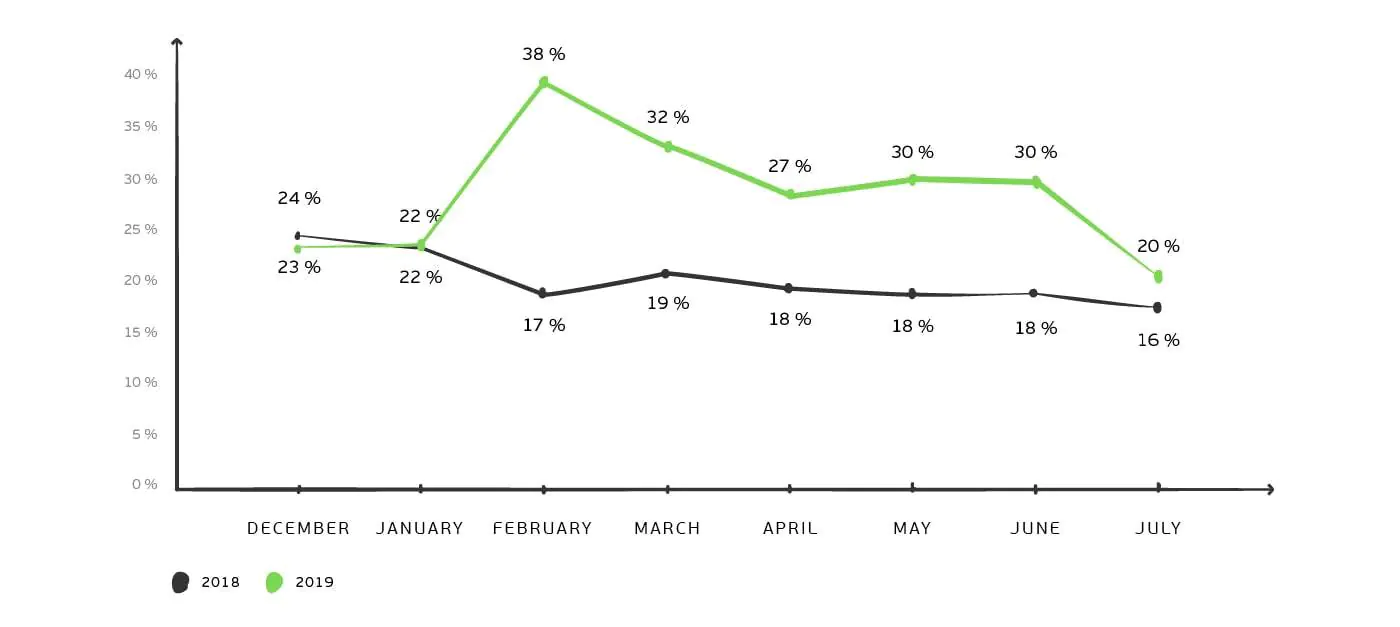
Share of automated communication revenue from all email channel revenue
Automated mailings bring the business approximately half of all revenue from their email channel. According to our mailing list summary report, automated communications make up only 7% of the total number of newsletters, but at the same time, they bring the online store 43% of all revenue from the email channel:
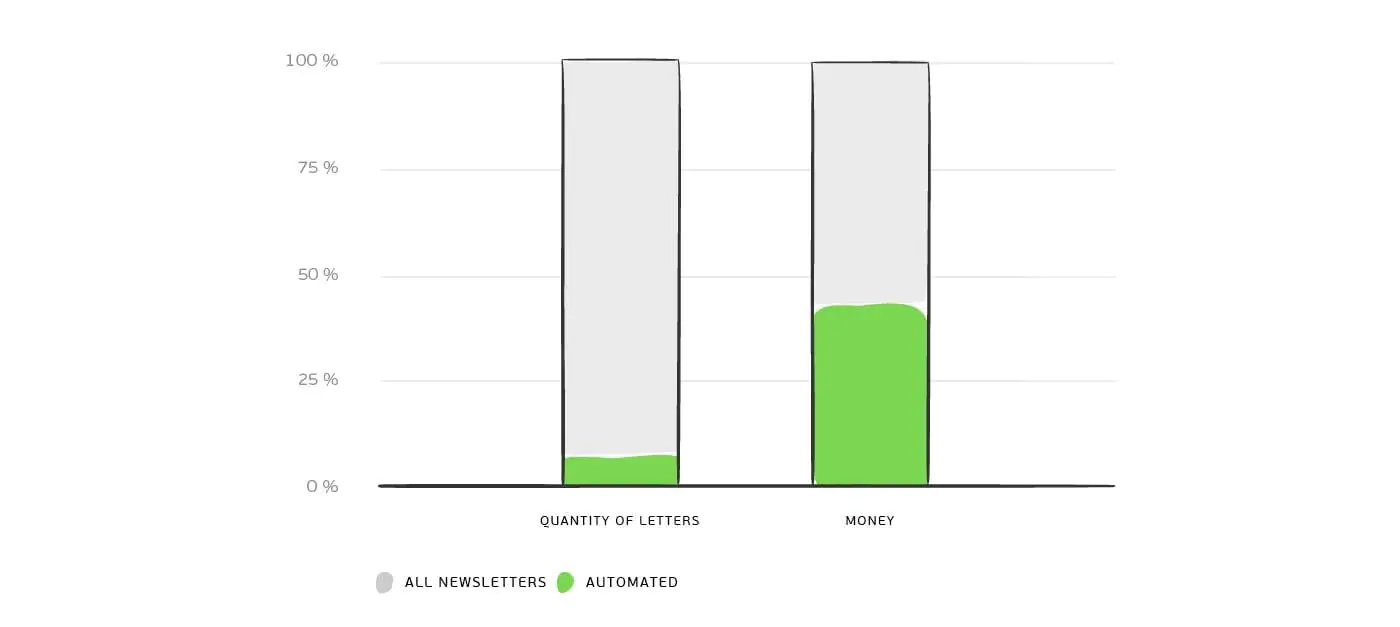
Additional revenue from product recommendations on the website relative to the control group
Spadream uses Maestra Product Guidelines on its site and measures their effectiveness using a global control group. Half of the website’s visitors see these recommendations, the second half does not.
Testing with a control group showed that people who see product recommendations make 20% more orders in general. The confidence level of our testing is 99%. Conversion to transactions was measured in Google Optimize:

Maestra ROI calculated for email newsletters
To calculate the Maestra ROI, we took the following data:
- Revenue from the email channel for 2018, from December to July. The period when Spadream marketers sent newsletters in parallel from three services.
- Revenue from the email channel for 2019, from December to July. The period during which marketers started working in Maestra.
- Margin
- Cost of services used prior to Maestra.
- The cost of Maestra, without VAT, from December to July 2019.
The Maestra ROI is ≈176%. The client requested us to not disclose exact numbers in this post, so we will only show the formula which we used to calculate ROI:

If the ROI exceeds the refinancing rate (as of 08/20/19 — that comes out to 7.25%), then the investment can be considered profitable. In the case of Spadream, the ROI is 176%. Therefore, every ruble invested in Maestra brings an additional 1.76 rubles to the business.
Before Maestra, we used three separate services for communicating with our clients. Triggered mailings and product recommendations were configured in one tool, manual ones in another, transactional messages were sent from our content management system.
In order to work from one window, summarize analytics for all our used tools and not overpay for unnecessary services, we decided to transfer all of our email newsletters and product recommendations for the site over to Maestra.
Firstly, we wanted to see how our customers would react to product recommendations displaying directly on the site: how they behave, what they buy, some statistics. The previous tool that was in use did not have the ability to provide this information.
Secondly, the subscription feed that was there from previous mailers included features that were not actually used. As a result, email newsletters were much more expensive than they are now.
The main task that was set before Maestra, was successfully met and completed by their team. And that was to transfer the operations of Spadream communication channels over to one system and save funds by cutting back on other services totally. In order to be sure of this, it was enough to compare our Maestra bills and previous ones.
Situation
The Spadream online store does not have an in- house marketing team. Their strategy is developed and realized by the Email Soldiers agency. Outsource marketers are responsible for all email communication relative to the project and are working to ensure that the online store site becomes an additional channel for communicating with customers.
Prior to Maestra, Email Soldiers specialists built marketing activities for Spadream using three services: one for manual mailings, another for triggered ones, and the third for on-site product recommendations. At first, this did not get in the way of work. But due to the client base growing, more custom advertising mechanics saw need. Therefore, things started becoming more complicated.
Email marketers found it impossible to check if a newsletter from the first service duplicates send conditions from the second one. Because of this, it so happened that customers enjoyed several identical letters in a row. It was discovered that a slew of customers was dissatisfied after support tickets related to the matter began piling up.
The complex process of converting analytics for comparing expenses and profits also left much to be desired. To see the email channels real profitability, it was necessary to download reports from each individual service, compare them in Excel, and then compare them with data derived from Google Analytics.
It should be noted that the owner of Spadream had additional reasons for migrating to a single system. According to him, it was necessary to pay for each individual service full rate, meanwhile not all of their aspects were used.
Maestra helped centralize our operations and reduce the time to search for defects thanks to the ability to work with all communication channels from one tool. Previously, I could have wasted several hours searching for errors in one service, and then finding out that the actual cause of the failure had to be sought out in another. Now, everything is totally different. If an incident occurs in any channel, I will quickly find the reason via the Maestra interface and fix things right up.
I would also like to note that the service provides a personal manager who helps implement our ideas on a technical level. With his support, we can, for example, add a block of product recommendations in triggered letters or connect web pushes directly on the site to expand our audience and boost sales.
The task
Spadream’s global goal was to increase business revenue. As part of this goal, two tasks were set for us:
- Transfer all communications with customers to Maestra from our old tools: transactional, manual, triggered mailings, and on-site product recommendations.
- Integrate Maestra with the site and accounting system to collect data on purchases, human behavior on the site and client reactions to newsletters, and store this data in the Maestra CDP.
Decision
The work was divided into two stages. The first involved transferring all mailings to Maestra, creating a single customer profile and configuring in letter product recommendations.
The second stage was to configure product recommendation mechanics in Maestra and test their effectiveness using a control group.
We will go over each stage in more detail.
We set up product recommendations on the site and checked their effectiveness using a control group
One of the reasons for transferring product recommendations from the old service to Maestra, was the ability to change widget settings without having to involve any side help directly in the Maestra interface and connect a control group to measure the effectiveness of the configured tool.
The client spent no more than five minutes installing recommendations on the site. The Spadream developers inserted a small bit of product recommendation code into the website’s main code, and now, these recommendations appear on the online shop’s pages automatically. Now the site has five widgets installed: categorical recommendations, in the product card, in the search field, in the shopping cart, and on the 404 page.
Each widget operates based on customer data. For example, in the category, buyers are shown popular products. This product list is based on real purchases for the last 30 days.
In the product card, we show similar products. In the search and on the 404 page — bestsellers. In the shopping cart — related products.
On the website, product recommendations appear like so:

The effectiveness of product recommendations was tested using a control group. As part of this task, we did not trust the last-click attribution because of the likelihood that a person would click on a product from the recommendation widget, but not because of a widget prompt, but rather because he or she was most interested in buying the product in question.
To exclude such cases of widget clicking in the test, we divided the website traffic in half: half of the users were exposed to widgets, the other half was not. Transaction conversions were measured through Google Optimize.
After 17 days of testing, we discovered that the group that was exposed to widgets with product recommendations completed 72 more transactions. Conclusion: buyers who see product recommendations make 20% more orders. The result is statistically significant, with a confidence level of 99%:

All Spadream email communications were moved from three sending services to Maestra
We started the transfer of mailings by transferring the historical database of email addresses from Bitrix to Maestra as well as from a service for manual and triggered mailings. After transferring, we integrated with the site in order to monitor buyer behavior in real-time.
Customer actions are stored in a CDP (Customer Data Platform), which receives data from various sources. In the CDP, each client is assigned a single profile. All contact histories with the brand are also stored in the CDP. For example, it’s possible to see which products were viewed by a client on the website, received a newsletter with a promotion for shampoos, but did not make a purchase.
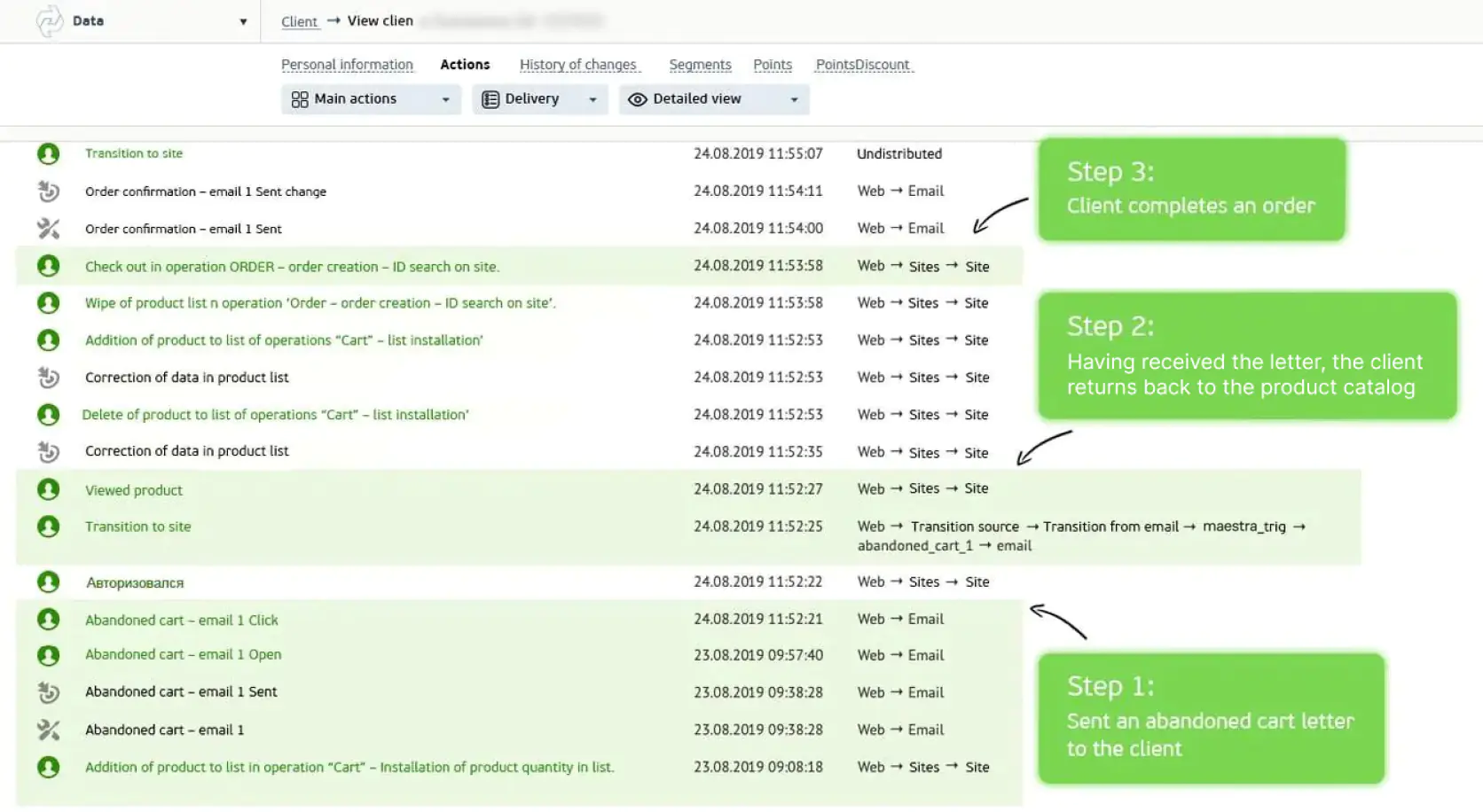
This is a screenshot of a single client profile in the Maestra system. Thanks to the on-site tracker, all personal and behavioral data are stored here.
The benefit of such a profile is that Spadream marketers work with clean data, which helps in the creation of a working targeted offer.
Thanks to the single profile feature, Spadream marketers were able to clear their entire database from duplicates and remove the contacts of people who had long been unsubscribed from mailings, but their data was lost due to work being done in three mailing lists at the same time. The clean database has greatly helped Spadream marketers segment their audience by their interests or behavior in order to create campaigns that match the interests of their target audience.
As an email marketer, I really like the segment designer in Maestra. The logic of constructing filters is not super easy, but it’s worth understanding. If you learn to use this tool, it will be easier for you to understand the needs of your clients: where they came from, their favorite products, average check size, etc.
After the integration and together with Email Soldier marketers, we began working on transferring all mailings into Maestra. The agency was responsible for collecting triggered chains from old systems, and help establish new sending conditions to Maestra. Now, the project has 28 automated campaigns, including:
- Abandoned shopping cart.
- Abandoned viewing of goods.
- Abandoned category viewing.
- Welcome chain.
- Registration campaign.
- Registration confirmation.
After launching standard trigger mechanics, Email Soldier marketers suggested adding a block with product recommendations to the triggered letters to increase email traffic. Maestra helped with the setup, and now all of Spadream’s automated newsletters possess product recommendations based on customer behavior.
To increase email traffic, triggered messages were configured to add a block with product recommendations automatically. Recommendations are based on real customer behavior. The machine learning algorithm analyzes the store’s catalog and locates popular and frequently purchased products in general categories and sections with brands, and offers them to clients:
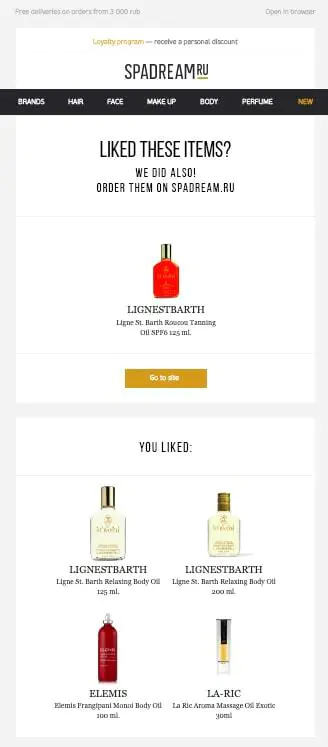
According to our mailing list summary report, automated communications account for 7% of the total number of mailings, while at that, bring the online store 43% revenue from the email channel:
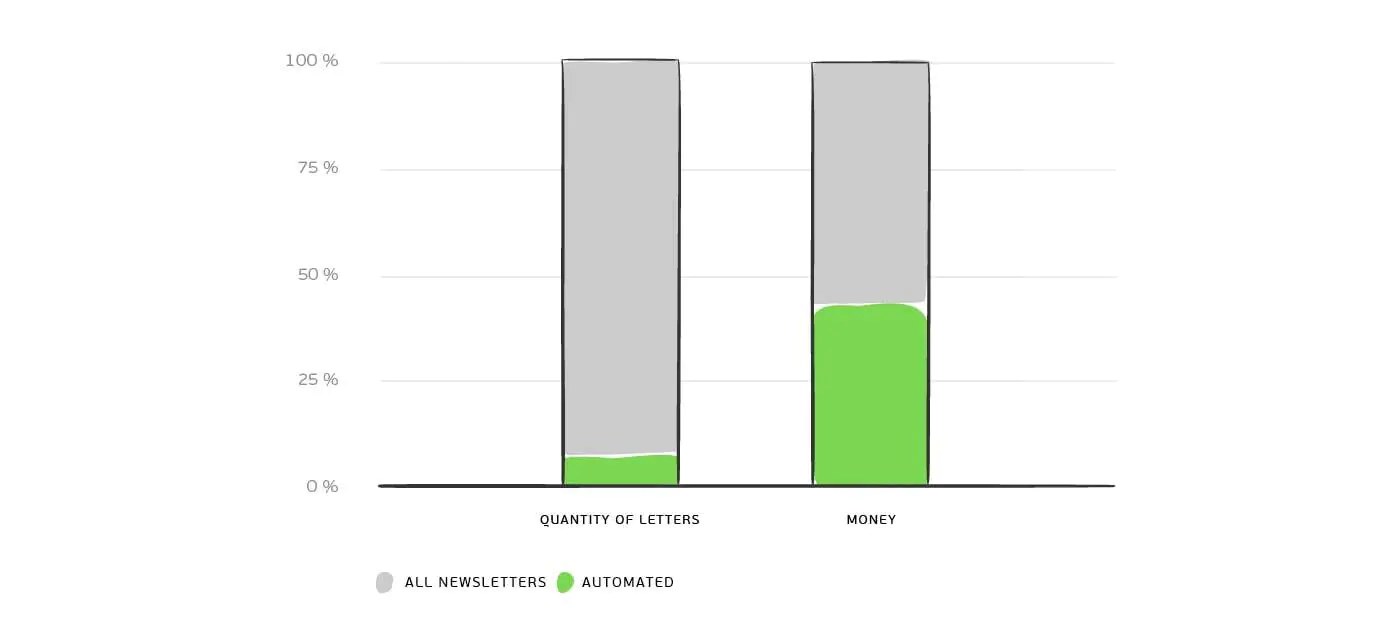
We have been working with Maestra for a long time, so now it’s hard for me to list all of the reasons why we once decided to cooperate. But there is one feature that I really appreciate and remember. To the Maestra team, it is unimportant who is on the other side, a direct client or an agency team, they never hide tariffs, allocate a personal manager to the project who will not give up if a difficult situation should arise, and focuses on solving the client’s business issues.






